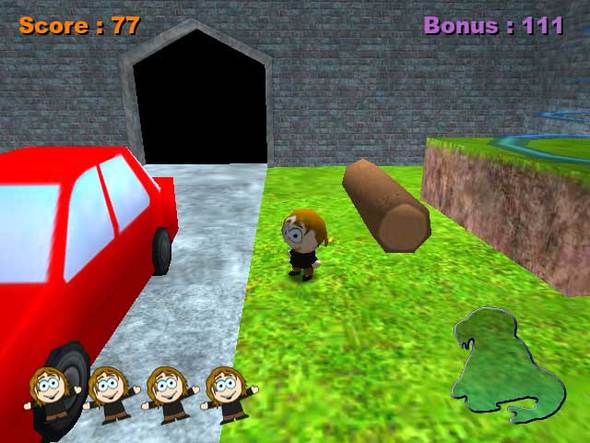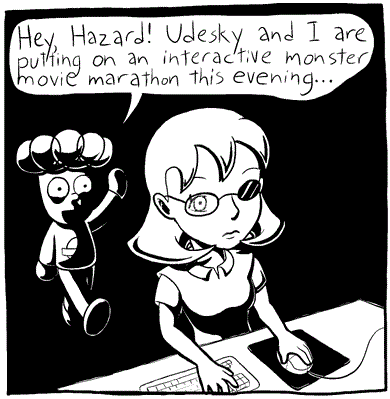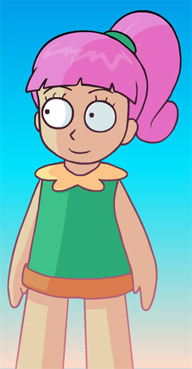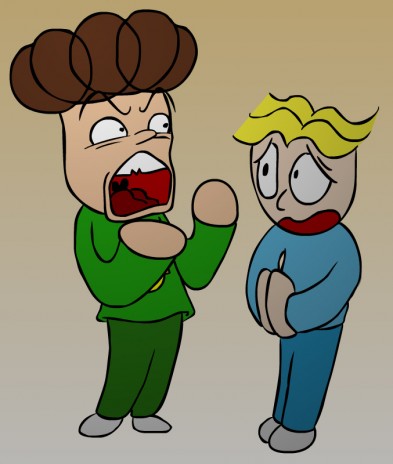I feel a bit bad for putting non-news in the news section of NG now that it appears a lot of people are actually using it for its intended purpose, but I suppose there isn't any harm. If you object to this, let me know and I'll stop. But for today, I present a long-coming (and very, very long) entry on The Brave Little Toaster.
If you haven't seen the movie, watch it. Rent it from Netflix or buy it from... wherever you can find it. If you can find a good quality VHS version, that's actually just as fine as the DVD. The DVD is grainy, wobbly, flickery, full of edge-enhancement, single-layer, and only has one mostly pointless special feature about the making of the direct-to-video sequels. Also, the DVD censors at least one shot. If you don't know which but have an obvious guess, yes, it's that shot. I remember it also being censored last time it was shown on Disney Channel, so I guess it's something Disney only noticed recently.
And if you've seen the movie but not the recent interview with Jerry Rees (director, screenwriter) and Deanna Oliver (Toaster's voice actress), watch that before reading this. Yes, it's an hour long, so if you don't want to spend that long watching an interview, do something else at the same time that lets you still pay attention to the audio. I was animating while I listened to it.
.
/* */
Continue reading once you've accomplished those two things. If you don't care to accomplish those two things, you probably won't care much about what I'm writing anyway.
First off, I think The Brave Little Toaster represents an ideal independent animated feature in many ways. In almost every way, in fact, except for the animation itself, which, although completely functional, is obviously outsourced and not particularly elegant. That would drag down a weaker movie; Disney's films almost always rely on enormous budgets and fluid animation to drive viewer interest, but The Brave Little Toaster didn't have that option, with a budget of under $2.3 million. Absolutely miniscule for an animated feature. As Jerry Rees said in the interview, Disney movies generally had ~$24 million budgets. And today? The Princess and the Frog had a budget of $105 million. No wonder Disney's not making as much from their movies as they'd like; they'd have to gross the Falkland Islands' GDP just to break even.
I'd talk about how noble the creators' goals were, not dumbing down the film because it's animated or because the primary audience will be children, but Rees said in the interview everything that needs to be said. The crew actually lived in Taiwan for half a year to oversee the overseas animators. That's devotion. And, as Rees pointed out, they pushed boundaries in ways such as putting the human protagonist in an interracial relationship-- That isn't boundary-pushing for the sake of shock or "Oh my god, they actually went there!" laughs (or worse, just for the sake of offending people), but for the sake of... well, justice.
And the musical score... Despite the small budget, the score transcends that of most (all?) modern high-budget animated features. David Newman did a wonderful job with the composition and the New Japan Philharmonic Orchestra did a wonderful job playing it. I'm surprised the NJPO isn't used for film scores more than they are; they seem to mostly do video games, but they've also scored Miyazaki films.
The songs themselves also stand out from those of other animated films. First, every song fits in a different genre, which is something I've always liked. Second, think about all the songs you've seen in Disney movies. Actually, since you're here, that means you've already probably spent a lot of time on TVTropes.org and think about fiction a lot in terms of what tropes they fit into. That's a bad way of looking at things and you should cut it out, but songs in animated musicals do tend to fall into a few categories. And those categories only apply to the songs in The Brave Little Toaster in a very loose sense; "City of Lights" doesn't consist of the characters singing specifically about who they are and why they're going to find their master, and only a few lyrics are actually devoted to conveying that, but it accomplishes the same purpose. If Disney made the movie themselves, the song would be a very on-the-nose affair in which each of the characters expresses his motivations exactly and clearly states his feelings in words. That's completely unnecessary, but ubiquitous.
Symbolism isn't something I like to get into much, since it's very easy for apophenia to take hold and in my opinion if it's impossible to be sure whether what you're interpreting as symbolism is deliberate or not, it may as well not be. But The Brave Little Toaster does a great job with subtleties and conveying important concepts abstractly. In particular, Rees mentioned the flower scene. I first noticed a couple of years ago that that was the point at which Toaster decided he should be nicer to Blanket. I don't think I made the connection that the flower was the same color as Blanket until I heard Rees explain it, but that's actually something that I feel probably isn't necessary to recognize on a conscious level. I don't believe in conveying information subliminally, but it helps with an emotional connection that the viewer may not even notice. I don't look at it as an "Ooh, clever!" thing, but as something that shows master craftsmanship in a way that the viewer only feels but doesn't necessarily notice. The movie's full of that sort of craftsmanship from the very beginning. Pay attention to the way the camera pans through the house. When the camera hits Kirby, for example, it then follows a trail of light leading from the Master's bedroom. That's not something someone thinks about unless deliberately scrutinizing the cinematography to analyze it, but it makes the flow smooth and natural, feeling like a natural progression through the house instead of just moving from one character to the next.
But if you want subtle details that will be completely lost on casual audiences that open up revealing new facets of the movie if you want to spend hours analyizing, you're completely in luck. The song "Worthless" in particular is absolutely chock full of... OK, a bit over a year ago I first noticed how cryptic a lot of the lyrics to that song are and I attempted an analysis. (Hold off on immediately reading the link; I'll explain next paragraph). While seeing if I could determine why Fellini (I correctly assumed Frederico) was mentioned in the song, I came across a blog by Susan Rothman that talks about the song. Rothman related information she gained from the person responsible for the "Worthless" sequence as well as some of her own analysis, and I learned a lot that I wouldn't have otherwise. Unfortunately, the blog seems to be gone now and I have no idea why, so I'm very glad that I found it when I did and am very disappointed that I didn't link to it directly so I might be able to access it again through the Wayback Machine.
The analysis is obsolete, however. There's a lot of speculation that makes sense but is unprovable, and some of the lyrics I couldn't understand at all turned out to be incomprehensible because the transcripts of the lyrics are wrong (including the clumsy subtitles on the DVD). I was recently contacted by email by Aaron Foster, who'd read my analysis of "Worthless", and we continued discussing it through email. I learned a lot from that discussion-- in particular, that I hadn't even been thinking in terms of the marriage of the song and the visuals that go along with it. I'd just been thinking about the song itself.
So I present here a newer analysis. I've tried to be careful not to include speculation that could be interpreted by readers as overanalysis, because although there is a very large amount of what appears to be deliberate symbolism, allusion, and insinuation, a lot of speculation in those regards leads to dead ends so for now I'll avoid it. I don't claim credit for "noticing" all that I write below, as several chunks were pointed out by Susan Rothman and Aaron Foster. The analysis isn't complete by a longshot, but it's better than the old one.
From the beginning of the song:
_____
I can't take this kind of pressure
I must confess one more dusty road
Would be just a road too long
Pretty straightforward. The blue car expresses anxiety, acknowledges he's no longer capable of fulfilling his purpose (and is thus worthless), and is immediately crushed into a cube. Unlike the subsequent cars, he doesn't resist his impending death.
I just cant- I just can't- I just can't seem to get started
Don't have the heart to live in the fast lane
All that is past and gone
The repetition in the pink convertible's first line is reminiscent of a car having ignition trouble, which is exactly what's happening onscreen when she tries to flee the magnet. She resembles a 1950s convertible and mentions "life in the fast lane", suggesting a history of Grease-esque drag races. I'm reluctant to include that here because it could just be a coincidence that fits very well, but each of the other cars alludes to era-appropriate history, often through obscure references, so I think this is a safe assumption.
I come from KC, Missouri
And I got my kicks out on Route 66
Every truck stop from Butte to MO
Motown to Old Alabama
From Texarkana and east of Savannah
From Tampa to old Kokomo
Starting with the red sports car, we get more specific lyrics. Here, we get fond reminiscence of Route 66, which was decertified and replaced by a highway system while The Brave Little Toaster was in production. This souped-up car shows his former owner's celebration of recreational driving and his sense of identity, which is great for Route 66 but not so practical for a highway.
Starting with the line "From Texarkana", look at the sports car's steering wheel. He's steering left and right, trying to drive off the conveyor belt and avoid being crushed, but he can't move.
I once ran the Indy 500
I must confess I'm impressed how I did
And I wonder how close that I came
Now I get a sinking sensation
I was the top of the line
Out of sight, out of mind
So much for fortune and fame
These lyrics are more overtly grim than those preceding. There's a great synchronicity of the visuals with the lyrics as the racecar slowly slides down the funnel as he sings "Now I get a sinking sensation."
Once took a Texan to a wedding
Once took a Texan to a wedding
He kept forgetting his loneliness
Letting his thoughts turn to home
And returned
Now the lyrics get a bit cryptic and into you-can't-expect-kids-to-get-this territory. To quote myself from 2009: "I spent around half an hour or so getting really frustrated that I couldn't make any sense from the wedding verse. I recited it to my father once he got home and gave him the context, and after thinking for a bit, he said he interpreted it as that, as a marriage is generally a social event in which everyone is very close together, the man observed how miserable/annoying people are after being together for a while (or he just became miserable/annoyed) and just wanted to go back home. That seems to fit given the nihilistic theme of the song."
I took a man to a graveyard
I beg your pardon, it's quite hard enough
Just living with the stuff I have learned
This car goes by pretty quickly, so try to freezeframe and take note of what kind of car it is. As if the lyrics weren't dark enough already, the man the car took to the graveyard was the corpse. He had a dead man inside him for a while (something I'm sure we all hope to never experience), and it disturbed him to the point that this is what he chooses to sing about as he approaches his own death.
Once drove a surf at the sunset
There were bikinis and buns, there were weenies
Fellini just couldn't forget
Pico, let's go up to Zuma
Pico, let's go up to Zuma
From Zuma to Yuma, the rumor was
I had a hand in the lay of the land
The car is a wood-paneled station wagon. To quote the book Disney, Pixar, and the Hidden Messages in Children's Films by M. Keith Booker (which I don't own, but Foster linked me to a preview of in Google books), "The evocation of surf culture by this particular verse, of course, immediately recalls (for those old enough to remember) the 1963 hit 'Surf City,' by Jan and Dean, the first surf music song ever to hit No. 1 on the Billboard Chart. The song famously tells of a California beach where there are 'two girls for every boy,' which the singers are visiting in their old Ford 'woodie.' This song, of course, is particularly relevant here because the station wagon involved is described as being dilapidated (lacking, among other things, a back seat or rear window), yet still usable and able to 'get me where I wanna go.'" Sure enough, the singing "woodie" does seem to lack a back seat and rear window.
The lyrics to the second line of this verse are slightly different on the soundtrack than in the movie. On the soundtrack, the woodie sings something like "There were kinis and huns on the weenies". The first line is usually written as "Once drove a surfer to Sunset", which Susan Rothman took to mean Sunset Blvd., which leads to Will Rogers beach, but in both the soundtrack and the movie, I think it sounds much more like "surf at the sunset".
It's hard to interpret the bikinis/buns/weenies line in a non-sexual manner. To quote myself from 2009 on Rothman's statements about this verse, which is all I can do since the blog now seems to be gone, "She made several cryptic statements about 'boners' that I couldn't quite make sense of, but using that as a base looked into Fellini and sexuality. Apparently, Fellini was a very loose man, having affairs and showing little respect for his wife. Fellini's films always contained autobiographical elements, and his film Amarcord was partially a self-mockery regarding his inability to 'outgrow foolish sexual fantasies'. I'm not even going to get into Satyricon. Anyway, the point is that the line is sexual and refers to the bikinis, buns and weenies obsessing Fellini. According to Susan, Fellini was referenced because his films include 'autobiographical images of himself laced into artistic works', which is what Cypherd was doing. This goes even further into the film with the TV including himself in a commercial for Ernie's. Cypherd told Susan that the advertisement for Ernie's Dump (eventually becoming Crazy Ernie's Amazing Emporium of Total Bargain Madness) represented 'elements he knows about packaging and slanted publicity in general'."
Right after Fellini is referenced by name for the sake of evoking his fourth wall-teasing (and in some cases, such as 8½, fourth wall-annihilating) movies, one of the station wagon's headlights falls off and smashes into your TV set, and Lampy looks through the resulting hole. This is the only instance of The Brave Little Toaster in which the fourth wall is broken, and in this case it's broken literally.
Rothman interpreted "Pico, let's go up to Zuma" as referring to Pico Blvd. and Zuma Beach, and since Pico Blvd. doesn't go to Zuma beach, Rothman suggested a sexual interpretation that I never thought made much sense. The line doesn't make sense referring to a street anyway, since it's an instruction. It's more simple than that: The car is remembering someone suggesting to the surfer named Pico that they go to Zuma Beach. The station wagon sings this line twice, hinting that this is an important memory. It'd have to be important anyway if the car chooses to sing about it right before dying.
Notice that the surfboard has a big shark bite taken out of it.
The final line in the verse is "Get up and go hit the highway," which is followed immediately by Rob (the Master) and Chris doing just that.
The station wagon lands on the conveyor belt upside-down and is unable to attempt to drive off, so she just tries to do a barrel roll. She is unsuccessful, of course, and is crushed.
The next verse was much harder to understand than it should have been because lyrics transcripts (and the subtitles in the movie) always get a line wrong. Here are the correct lyrics.
I worked on a reservation.
Who would be believe
They would love me and leave
On a bus back to old Santa Fe?
Once in an Indian nation
I took the kids on the skids
Where the Hopi was happy
'Til I heard 'em say:
"You're worthless."
The Hopi Reservation is located in Arizona and is inhabited by the Hopi and Arizona Tewa. The bus left "back to old Santa Fe". The word "back" implies a return, and sure enough, the reservation in Santa Fe is the Nambé Pueblo, inhabited by the Tewa tribe, of which the Arizona Tewa are descendants.
The truck sings about taking poor Hopi children off skid row until he was no longer deemed necessary, at which point he was told he was worthless and was abandoned.
Unlike the other cars, this truck drives away when the magnet approaches, but not to escape. He deliberately drives onto the conveyor belt, effectively committing suicide. He acknowledges that his time is over, but he prefers to exercise the small amount of freedom that remains to him by choosing death himself rather than being forcefully dragged into it.
_____
Was I going to say anything else about the movie? I guess just that I'm very disappointed in Disney for not treating it better. It was denied a theatrical run because Disney wanted to premiere it on their new Disney Channel (Effectively making The Brave Little Toaster the first Disney Channel Original Movie. Shame DCOM quality didn't remain consistent). And, particularly heartbreaking, the movie was denied the grand prize at Sundance despite the judges considering it the best film that year because they were worried people wouldn't take the festival seriously if they gave the prize to a cartoon. This sort of discrimination would be horribly frustrating even if it were based on the judges' own values, but it wasn't. They were worried what other people would think of them if they did something as subversive as give the award to an animated film. You'd think that flies in the face of the "independent spirit" or whatever it is Sundance is supposed to stand for. I wish Rees had revealed this sooner, because... well, what better reason is there for people to not take Sundance seriously than knowing the awards are rigged?
![Re: Brave Little Toaster]()




